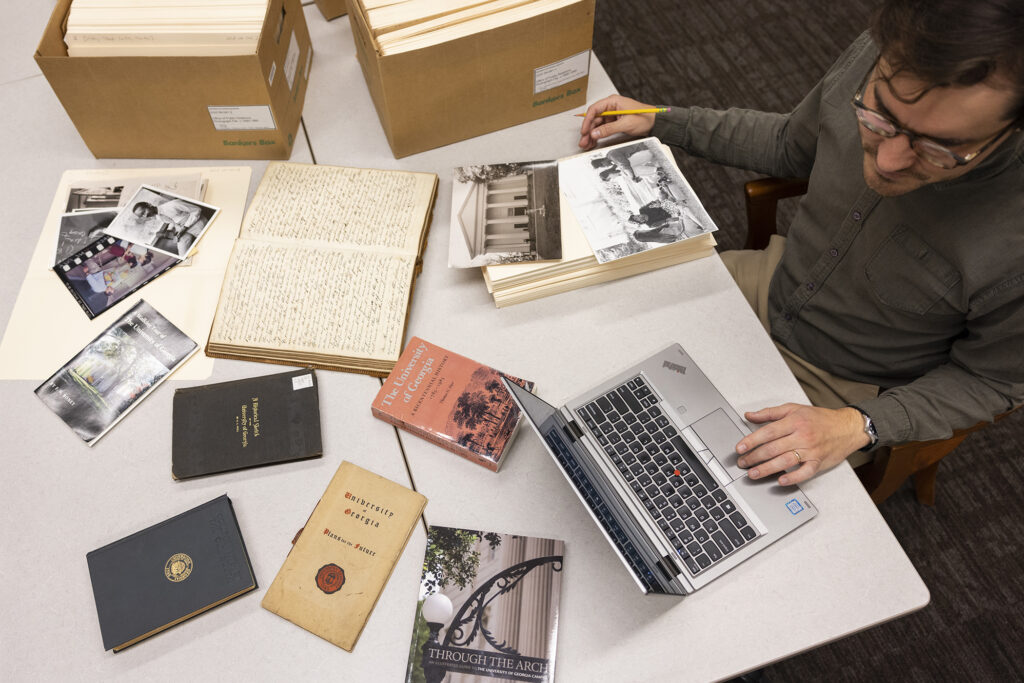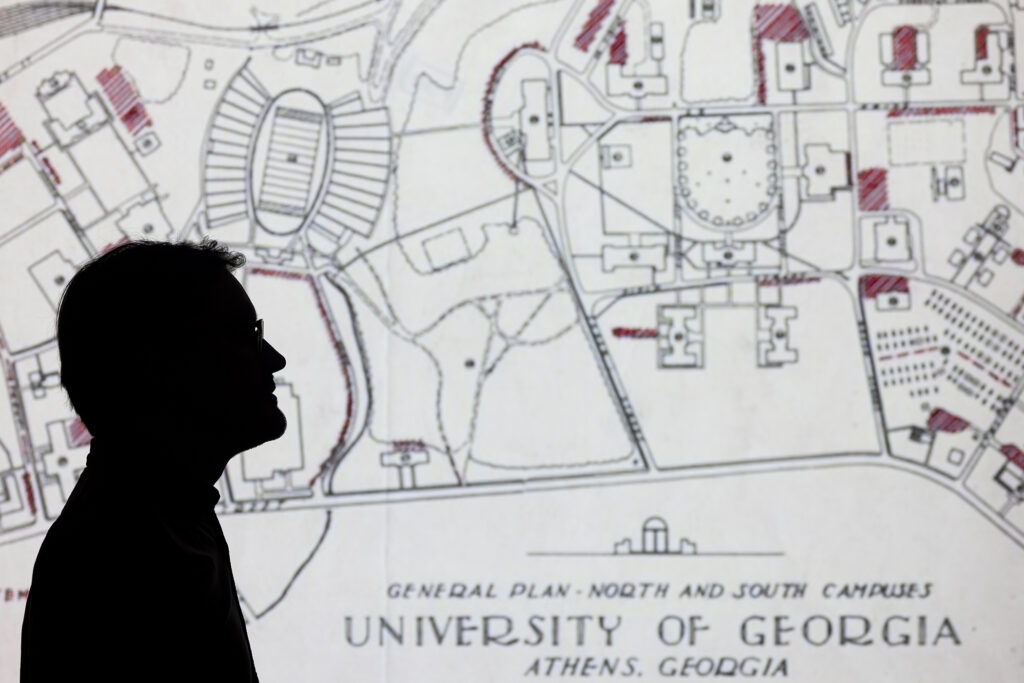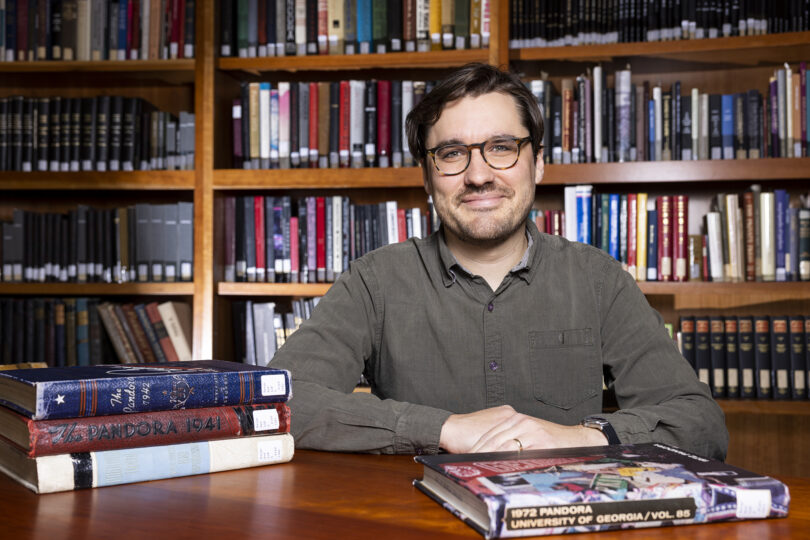At the birthplace of public higher education in the United States, preserving more than two centuries of a university’s history takes on a special responsibility.
Yet, at the University of Georgia Special Collections Libraries, university archivist Steve Armour notes that ensuring the security of the digital records of today is just as important as caring for UGA’s founding documents.
“It’s a privilege,” Armour said of his role in the preservation of the first state-chartered public institution of higher education. “The University Archives is UGA’s hub of institutional memory. My main job is to collect, preserve and provide access to these records. That may sound straightforward, but each facet of the job comes with its challenges and decisions. What’s considered important enough to be archived? How are born-digital records preserved and accessed? How can we make sure that scholars can discover our collection from anywhere in the world?
“Some of these questions have more than one possible answer, and we archivists are always leaning on each other’s expertise and striving to find the one that best fits the needs of our users,” he said, referring to his colleagues at the Hargrett Rare Book and Manuscript Library.

Steven Armour, university archivist, processes an archival collection at the Special Collections Libraries. (Photo by Chamberlain Smith/UGA)
Armour grew up a few counties away from Athens, cheering for the Bulldogs, but never imagined his future would involve caring for the memories of the university. He received his bachelor’s degree from Georgia College and was working toward a dream of a career in public libraries when he got a job as part of a moving team on a very special project.
In 2011, the three units of the UGA Special Collections Libraries had outgrown space at the Main Library and were transferring priceless artifacts to a new Hull Street building, complete with gallery spaces, instructional classrooms, and a state-of-art, 300,000-square-foot temperature-controlled vault. While studying for his master’s degree in library and information sciences through an online program at Valdosta State University, Armour was applying his skills to the logistics of the move, and that’s when he fell in love with the work of special collections preservation.
“As I learned more about the different types of libraries and archives, the opportunity to preserve historic records and connect people with one-of-a-kind resources felt right at home to me,” said Armour, whose wife, Mollie, is also a librarian at UGA. “I find archives inspiring because they make history tangible and immediate, rather than an abstract series of grand, sweeping events. Every person, place and thing has a history, including those in our own community and campus. You probably won’t get that from a textbook, so archivists are here to help people dig.”
In thousands of archival boxes storing more than 200 years of history involving the education of hundreds of thousands of citizens, scholars can find pearls of wisdom, as well as decisions that were later found to be mistakes. Either way, Armour explains that preserving this history only aids in the ability of future leaders to learn from missteps and move forward in the modern era of academia.

For Steven Armour, archiving continues each year with new records, Pandora yearbooks and commencement programs, University Council minutes, official letters, photographs, campus maps and plans or other documents. (Photo by Chamberlain Smith/UGA)
And the archiving continues each year with new records, Pandora yearbooks and commencement programs, University Council minutes, official letters, photographs, campus maps and plans or other documents, as Armour works to ensure that the memories are preserved and accessible to students, researchers and the public to discover more about the state’s largest public university.
Like many higher education history experts from across the nation, Armour has a certain affinity for UGA’s original state charter, signed by members of the state legislature in 1785.
“It’s time-worn, and the original hand script is barely legible—thankfully it’s transcribed—but that also gives it character,” he said.
But Armour notes that another of his favorites in the archives is based on more recent history. A couple of years ago, Armour and his colleagues were awarded a grant from UGA trailblazer Charlayne Hunter-Gault’s Giving Voice to the Voiceless Fund to create the UGA Black Alumni Oral History Project, a series of interviews with Black UGA alumni who attended the university in the 1960s and ’70s. Those narratives, he explains, serve to document the experiences of Black students in the years after desegregation to ensure that those pivotal stories remain for future generations.
The University Archives also preserve items from UGA Athletics history. While a Hargrett Library colleague serves as a specialist for that collection, Armour enjoys working closely with items that form the Bulldog legacy. The football team’s latest trophy will be on display at Butts-Mehre Heritage Hall and Sports Museum—at least when it isn’t touring campus and the state in celebration of the 2022 National Championship. But there is another trophy in the vault at the Special Collections Building that Armour loves to share about because it is symbolic of the Bulldog journey.
“In 1894, Georgia beat Auburn 10-8 and took home a trophy in the form of a small, silver chalice. It’s our oldest surviving artifact from UGA’s football program, which was only 2 years old at that time, and it’s kind of quaint and marvelous,” Armour said. “The game was very different back then, and it was too early for any kind of legacy, but that modest chalice feels like the start of something grand.”
That symbol also resonates with Armour’s career from the beginnings of the Special Collections Libraries Building—or even for the University of Georgia itself, chartered before the signing of the U.S. Constitution.
“Because of UGA’s status as a large R1 land-grant institution, our history and our records connect in many ways with state and national history spanning well over 200 years,” Armour said. “Whether you’re interested in science, agriculture, politics or athletics, there are a million stories in the University Archives waiting to be told.”








